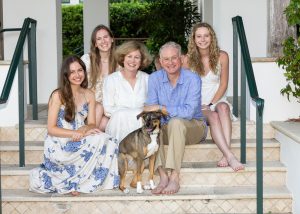East Tennessee Foundation pools resources, invests wisely and serves nonprofits in 25 counties
Amy and Robert Cathey wanted to share with their three daughters the desire to give back to the Knoxville community. So they set up a fund through the East Tennessee Foundation to make that happen — year after year.
The Cancer Support Community needed a new building to house the myriad programs they host for people impacted by the disease. An endowment fund the nonprofit established at the East Tennessee Foundation 20 years ago allowed them to purchase and renovate that home — without the need for a mortgage.
When Legacy Parks Foundation was just getting started in 2005, they leaned on the East Tennessee Foundation to provide the infrastructure and financial management they needed. An endowment they started there helps make ends meet in lean years, says Legacy Parks executive director Carol Evans, and keeps on growing in good ones.
The East Tennessee Foundation, established in 1986, supports nonprofits in 25 counties by pooling donations, investing wisely, and distributing funds in a variety of ways, from college scholarships to far-reaching perpetual endowments. Across the country, about 900 community funds do similar work. “We’re in the top 50 based on assets,” says Angelia Nystrom, vice president of advancement. “That’s a testament to the work we do and the generosity of the people in this region and their desire to have an impact on our communities.”
How it works
The foundation accepts gifts of all sizes — from $25 to at least $25,000 to establish an endowment fund. Those funds flow back out to everything from Project Grad to the Pat Summitt Foundation. When the Smoky Mountains burned in 2016, the East Tennessee Foundation was quick to establish an opportunity fund to help those in need in Gatlinburg. It was able to collect resources from many sources, vet the organizations working in the aftermath, and funnel the funds into the pipeline. “We raised a lot of money and put it to good use,” says David Martin, honorary lifetime board member and fund holder. “An individual donor wouldn’t be able to do that.”
In 2022, the East Tennessee Foundation managed total assets of $504 million in nearly 500 different funds and distributed $22 million in grants and scholarships. (Assets for 2023 were $540 million, though the complete annual report was not ready when this was written.) Nonprofits in Knox County received nearly 600 grants totaling $11.5 million in 2022, while nonprofits in Anderson, Blount and Jefferson counties received upwards of $600,000. Other counties ranged from $1.2 million (Greene) to $2500 (Roane). In addition to its own board of directors, the foundation receives guidance from 17 regional affiliate fund advisory boards.
Fund holder George Conner noticed in the 2022 annual report that Unicoi County had received no disbursements. He contacted the foundation and they identified a food pantry in need there. The next year the food pantry received $1,000. “It’s good to seek charities that contribute to the wellbeing of others,” Conner told the foundation, “and there are lots of good charities out there.”
Two hundred thirty-five students, one-quarter of whom were first-generation college students, also received a total of $1.1 million in scholarship funds in 2022. Students at Central High School in Knoxville were among them, thanks to the generosity of the Class of 1950, which in 1980 established a scholarship fund to benefit Central seniors. That year they awarded $400, but they continued to pool their funds and in 1996 were able to establish an endowed scholarship with the East Tennessee Foundation. Since then, more than $118,000 has been awarded to 76 recipients.
A variety of funds

Some donors, like Amy and Robert Cathey, open a donor advised fund, which allows them to get involved in grant making. “We wanted a fund that would provide the basis so we could perpetually make a donation to the foundation’s operating fund,” Amy Cathey said. “And we wanted our three daughters to have an example of the importance of giving. This Christmas, one of the girls’ gifts was to select a nonprofit they are passionate about to receive a small grant in their honor. It gave them exposure to the impact their gift was able to make. It’s a family tradition we will continue.”
Other donors contribute to field-of-interest funds, which funnel multiple donations to grants for which nonprofits can compete. Those fields of interest include arts and culture, women and children, education, health, disaster relief and community development, among others.

Nonprofits can establish their own endowment funds that grow over the years, as the Cancer Support Community, the Legacy Parks Foundation and roughly 100 other nonprofits have done. “An endowment’s a weird thing,” says Beth Hamil, the Cancer Support Community’s executive director. “We have an endowment fund that the foundation manages, and we have to work together to spend it. It’s sort of like a savings account.
“We were outgrowing our previous home, and the board and staff had been dreaming about a new location. Our founders had established the endowment fund for us 20 years ago, and the foundation has managed that money. It helped us make this dream of a new home on Baum Drive a reality and palatable financially. We used a lump sum of $1.2 million from the endowment and then raised $1 million to renovate the building without a mortgage.
“The endowment is a rainy-day or do-something-important fund. And the new building was deemed important so we could deliver our programming in the right way. We’re thrilled to be here.”
Not only do endowments serve as “savings accounts,” but the foundation also provides investing expertise and back-office knowhow that allow nonprofits to focus on what they do best, says President and CEO Keith Barber. “Our mission is enabling those organizations, through various ways, including getting them grants or scholarships, to do the work that they’re experts in. If we can take some of the burden off of them, it’s awesome.”
Meeting donors’ needs
Just as the foundation serves the nonprofit community, it also serves donors with a range of needs and interests. If a donor wants to make an estate gift of a piece of property, for instance, the foundation would establish an agreement with them, handle the sale of the property and help them leave a legacy with the causes they care about. Individual nonprofits often would find that process too cumbersome to take on.
“We helped a couple establish a fund in memory of their daughter to benefit the organizations that were dear to her,” Katharine Killen, vice president of programs and chief operating officer, says. “It will exist in perpetuity, and it will keep her memory alive forever.”
Responsive giving
Looking ahead, Barber wants to expand the foundation’s opportunity fund, the same one that fed help to the residents of Gatlinburg post-fire. “It’s the fund we have that we can direct monies toward issues, for instance, the housing issue in greater Knoxville. Or equitable health care. It’s funds that are more flexible to be used when initiatives or needs pop up. So we’ll put some emphasis on that this year, and I believe our community is going to step forward and help do that. We have proven to be a very substantial entity that can be relied on as a philanthropic bank, if you will, that the community can count on and donors can count on to make a difference.”
“At the end of the day, we want to be able to help people fulfill their philanthropic goals,” Killen says. “We want to be the bridge between philanthropists and nonprofits.”
